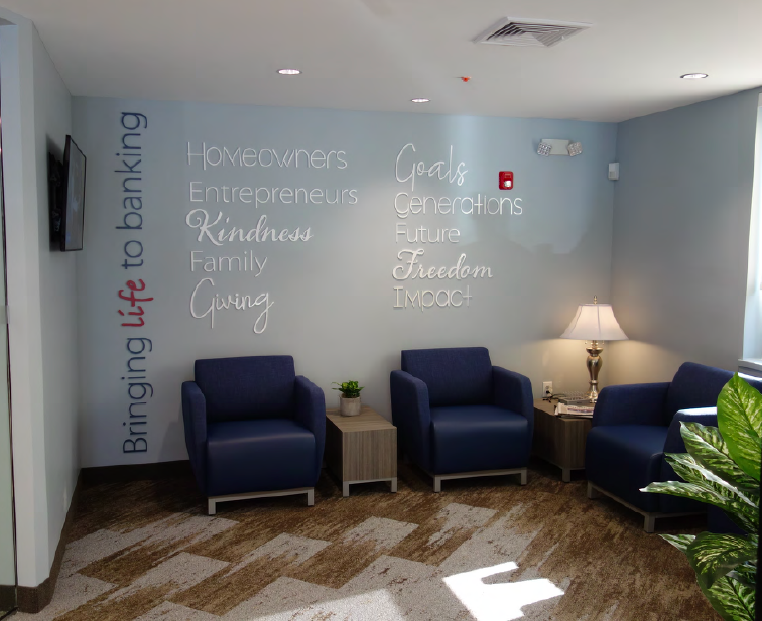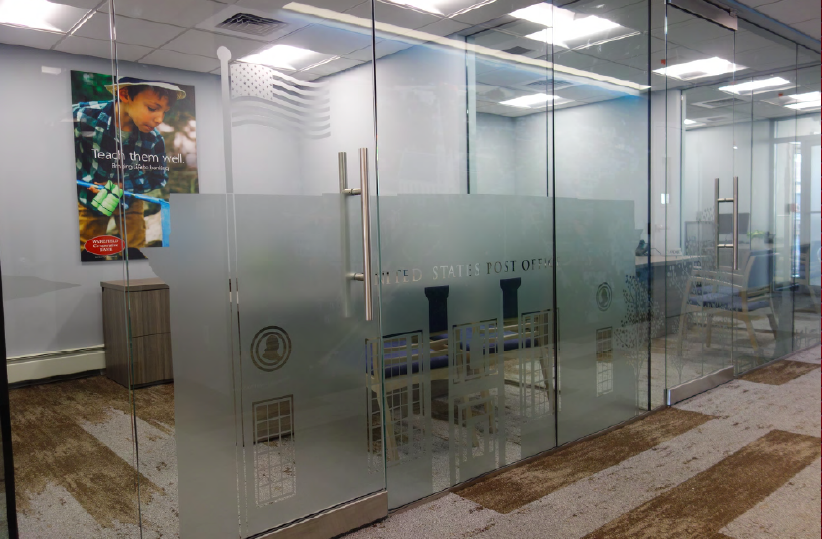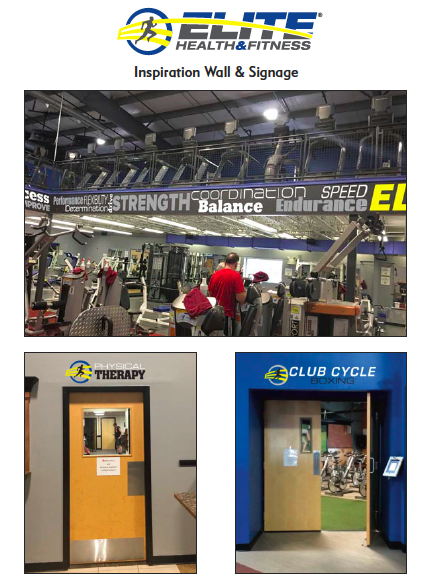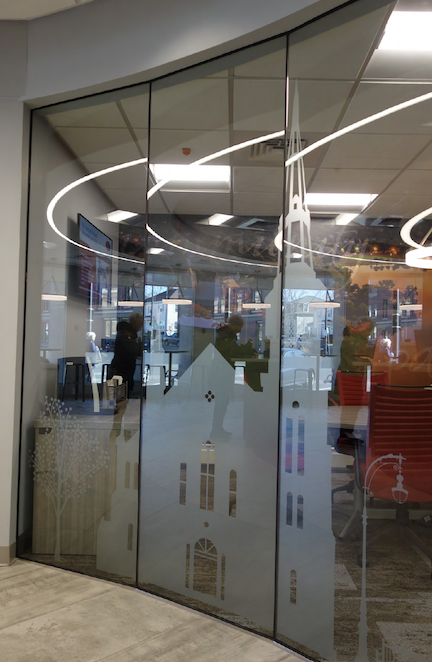What makes a good first impression? In answering this question, you may think it’s the people who communicate with your customer directly: student ambassadors, bank managers, concierges, or customer service representatives. And of course, they all do. However, that’s not the end of the story. In fact, your office space makes an impression the minute a customer walks through the door. Read on to learn how experiential graphic design can make your space your best advocate.
Experiential Graphic – What?
Experiential graphic design (XGD), often referred to as experiential branding, is a long name for a field that centers around one idea: experiences. First impressions are everything. Although you personally may make a great first impression, your space is the ultimate determinant. It primes your customer for how they perceive you – and your company. It’s crucial to craft your space in a way that best represents your company, its values, and its mission. It’s signage. It’s artwork. It’s pretty much anything you can dream up to represent your brand on-site. So how can you stand out when it comes to branding your office, branch, shop, or museum?
There are six different areas of XGD: digital experience content, placemaking and identity, public installations, interactive experiences, exhibitions, and wayfinding. We will experience each area together in this blog post, wayfinding our way through XGD – if you will. You may find that you only want to apply one segment of XGD to your space. Or, you may want multiple. Whatever the case, Triad’s here to help.
1. Digital Experience Content
Digital experience content involves anything electronic, from TV screens to larger-than-life LED walls. Incorporating digital displays into your space communicates your modernity and can also break the barriers of reality. For example, Scholastic installed an 18-foot LED wall that looks like a floating bookshelf in its New York City headquarters. The display adds vibrancy and joy to the space, while also reflecting the magic as seen in J.K. Rowling’s novels.
Digital installations can also be dynamic. Oftentimes, combining movement with abstract designs can help communicate the emotions and attitudes of the company through colors and shapes. A great example is when The Allen Institute for Brain Science collaborated with Studio SC to transform their busy location on the street corner into a place for contemplation and advocacy for their brain research. The wall resembles the neural pathways of the brain and the communicative pathways between the Institute and the surrounding community. Dynamic displays bring your message to life and encourage contemplation for the viewer.
2. Placemaking and Identity
All segments of XGD should involve placemaking and identity. After all, knowing who sent a message makes understanding it easier. While logos and branded merchandise can demonstrate who you are, you can also placemake with colors and patterns.
An experiential branding project we recently completed for Needham Bank’s first Boston branch is an excellent example of placemaking and identity. Needham Bank wanted a mural that exemplifies community, diversity, iconic Mission Hill landmarks, and the multitude of ways they help their customers build something great. With the help of our muralist, Julie Borden, we accomplished this task by bringing the outside in.
Vibrant colors, silhouettes of residents, sketches of Mission Hill, and hearty trees demonstrate the threads of community, diversity, and dedication in both the town of Needham and Needham Bank. By combining abstract triangular shapes with realistic drawings, Julie grounded Needham Bank in both the physicality of the community and its emotions.



Ultimately, placemaking and identity boils down to what makes you YOU. Of course, we can help you figure out exactly what that may be.
3. Public Installations
Want to make a big impact? Here’s your chance. Public installations are pieces of artwork or other objects that respond to certain topics, landscapes, or cultural trends. When you hear about public installations, think memorials or landmarks.
One of the most famous examples of public installations, which gained global recognition, was State Street Global Advisors’ “Fearless Girl.” On the eve of International Women’s Day, State Street installed a bronze statue of a young girl, sculpted by Kristen Visbal, staring fearlessly at the iconic bull statue on Wall Street. The installation advocated for gender diversity in leadership, and had a remarkable impact.
Fearless Girl had over 10 billion social, print, and digital media impressions.
State Street Global Advisors
Of course, not everyone has access to Wall Street. However, public installations can raise awareness of your brand’s values, mission, and supported causes. For more information on the process of public installations in Boston, click here.
4. Interactive Experiences
What better way to maximize consumer experience than making them a part of the display? Interactive experiences are at the heart of XGD, as they tangibly guide the consumer’s experience with the space.
Interactive experiences are growing in popularity among various fields and situations. For instance, trade shows oftentimes include interactive experiences so consumers can get a literal feel for a company and its products.
Colleges have also encouraged interactions between students and schools through different building features on their campuses. The Anne T. and Robert M. Bass Biology Research Building at Stanford University collaborated with Knot to create an interactive experience titled “Morphogenesis.” The experience was created as a celebration of the building’s completion, but soon evolved into a beacon for creativity and research at Stanford. At the front of the building, a large LED screen replicates the patterns found in nature, as theorized by Alan Turing. However, the patterns are created by users following a tutorial on a platform located at the bottom of the building. So far, 8,000 designs have been created and displayed, becoming the face of Stanford’s building.
Whether it’s an interactive whiteboard or picture display, interactive experiences allow the consumer to become part of your space, and eventually part of your brand.
5. Exhibitions
Ever notice how museums are incredibly quiet? The silence is not just a social norm. Rather, the quiet gives people room for thinking. About what? The exhibitions.
Exhibitions contain a collection of purposefully arranged art works or items of history that are publicly viewable in museums, galleries, or other institutions. They span across a wide range of fields, from science, to art, to history. A notable example of exhibition is the Against the Odds: American Jews & The Rescue of Europe’s Refugees 1933-1941 exhibit at the Museum of Jewish Heritage in New York. The exhibit displays the letters exchanged between European Jewish refugees and their American relatives right before WWII, separating different periods of time with walls of floating pages which represent bureaucratic barriers. Using exhibition, the museum gave the letters the voice they needed.
In terms of branding, exhibition may or may not apply to your company office. However, the creative arrangement of artwork is something to keep in mind when considering the layout of your space.
6. Wayfinding
Walking into a building that lacks signage has the same anxiety as finding a class on the first day of school. You’re new to the space, lack experience, and everything seems a little intimidating. As a business, you don’t want your customers feeling like a newbie. That’s where wayfinding comes into play.
Wayfinding refers to the signs, colors, and objects that navigate a consumer through your space. Think of it as a mall directory or an elevator sign. While you could just print out a sheet of paper that says “This Way to The Office,” it would not improve the consumer perception of your company. So, as our slogan states, “think success” when it comes to wayfinding. The angel is in the details, in this case.
While organizing a space has always been important, wayfinding will become increasingly influential as businesses and other institutions reopen. Social distancing rules will interrupt the normal flow of a space, calling for creative redesign. The New England Aquarium distances their customer traffic with penguin paths and more. You can also separate spaces with glass etchings, which add privacy creatively.

Floor decals, hand sanitizing stations, and safety posters can all act as brand ambassadors for how responsible, safe, and awesome your company is. And, you can find them all on our reopening resources page.
So, your newest customer walks into your office, branch, school, or museum. While you’re in the middle of organizing papers and files, they wait in the common area. However, the stress is no longer on you alone to make a great first impression. Your office has already welcomed them with open arms. The branded posters in the hall were more than “good signs.”